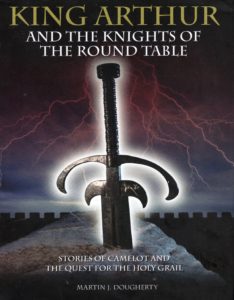Book Review: King Arthur and the Knights of the Round Table by Martin J. Dougherty
The Arthurian mythos is a familiar one to just about everyone in some form or another. But unless you’re a scholar of the subject, you might not know where all the pieces came from and how they got put together. This “coffee table” book gives an overview of basic information about King Arthur and his knights.
This generously illustrated tome begins with a look at what we know of early British history, and historical figures that might have inspired the tales of Arthur, even if no actual King Arthur ever existed.
Then it moves on to the major sources of the Arthurian stories. The first written account we still have is that of Geoffrey of Monmouth, whose Arthur is just one in a line of probably fictional rulers. The book also covers the romances of Chrétien de Troyes (who was big on graphic violence and courtly love), the Grail Quest (heavy on the preachiness and religious allegory), and of course Thomas Malory’s Le Morte d’Arthur, which pulled material together from multiple sources and added some of his own touches.
A final chapter touches on modern retellings of the Arthur cycle, from Mark Twain’s satirical proto-science fiction work A Connecticut Yankee in King Arthur’s Court, through the musical Camelot to the recent television series Merlin. The author also talks a bit about what might be called tertiary Arthuriana, where a character could say, “this bell was enchanted by Merlin” with no other references to King Arthur, yet the audience will immediately know what’s being talked about.
This book is for the layman, and should be suitable for tweens on up. (Parents of younger readers might want to discuss the theme of marital infidelity that comes up in the relationship of Sir Lancelot and Queen Guinevere, as well as other places in the Arthurian cycle, not least Arthur’s own birth.) There is an index, but no bibliography, so serious scholars will want something more advanced to work with.
The author also talks a bit about the enduring appeal of King Arthur and his stories. Heroic knights and chivalry, a struggle of good against evil, a kingdom where right is more important than might, even if it is doomed to fall and be followed by a darker age. “A moment so bright it will be seen on the far side of that darkness.”
This book would make a good gift for the casual fan of things King Arthur, especially bright teenagers. Did they like the recent movie?

